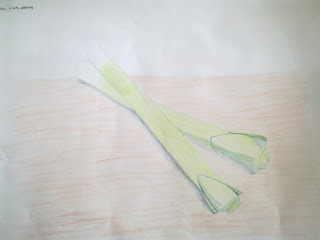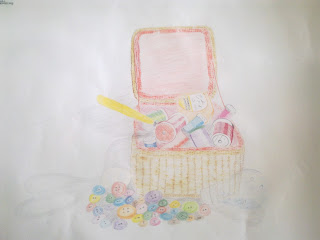 |
| Assignment 1 - First Drawing Natural Forms |
 |
Assignment 1 - Second Drawing Man Made Objects
|
Did you do enough preliminary work before starting work on your final piece?
No, is the simple answer. I was anxious that I would have to rush the assignment, so I spent quite a lot of time thinking about it, about what I was going to draw so that by the time I was ready to do it, I had already decided in my mind what I wanted to do. I did not document these thought processes so when I came to do the assignment, I was already doing the preparatory work in retrospect, if that makes sense. I did however go through the motions of doing the rough sketches as described in the assignment. I did find it useful to look at the sketch and before starting the actual assignment drawing to consider what techniques I had learnt in the past few months and how I was going to incorporate them. By doing the rough sketches, I also decided I would do the assignment in colour which made me check all my pencils and collect together a good selection of shades etc. So although in drawing terms I don't think I did enough prelim work, in thinking terms I was well prepared and knew what I was going to do before starting the assignment.
Do your large drawings give an accurate interpretation of the still life groups? If not, what went wrong?
I am extremely pleased with my results. Three months ago I had never drawn anything. Even at school I was transferred from the painting class to the textile class at 14 years old because I was not good enough at drawing / painting. I cannot believe that I have produced the drawings. I am really pleased with my results but realise that they probably fall very short of undergraduate work so I welcome all feedback.
Did you make a good selection of objects or did you try and include too much? Would you change the arrangements of the objects if you were to start again?
The first still life I did was the basket of threads with buttons. I think I made a good selection of objects but there were too many (& unnecessary) buttons!. I chose the basket to practice frottage and produce texture, the scissors to produce an interesting shadow, the daylight light bulb to introduce transparency, the rayon threads because their sheen surfaces reflect light nicely and the buttons to try and cheer up the drawing and have something at the base of the basket. There were too many buttons in the end but I liked the bright and cheerful dimension they gave to the drawing.
The second still life were the leeks and I deliberately chose only 2 to give me a good change to study the natural shadows, reflections and textures which I knew I would find more challenging to do. I also saw the opportunity to do some negative space technique.
Do your drawings for well on the paper or could they be improved by working on a larger sheet of paper?
I was at the limit of my comfort zone drawing on A2 paper. I don't think at this stage of my learning I could produce anything on a larger piece of paper without a lot of practice first.
Did you have problems with drawing or find hatching too difficult.
No. These are all new skills to me. I am the sort of person who thinks that there is no reason why I should not be able to do something so it would not occur to me to think that I am having a 'problem' with any of the learning. My view is that I am learning new skills, am comfortable with what I am learning and however I learn and whatever skill I develop it will be to the best of my ability at that moment on time. I am a positive person when it comes to learning.













